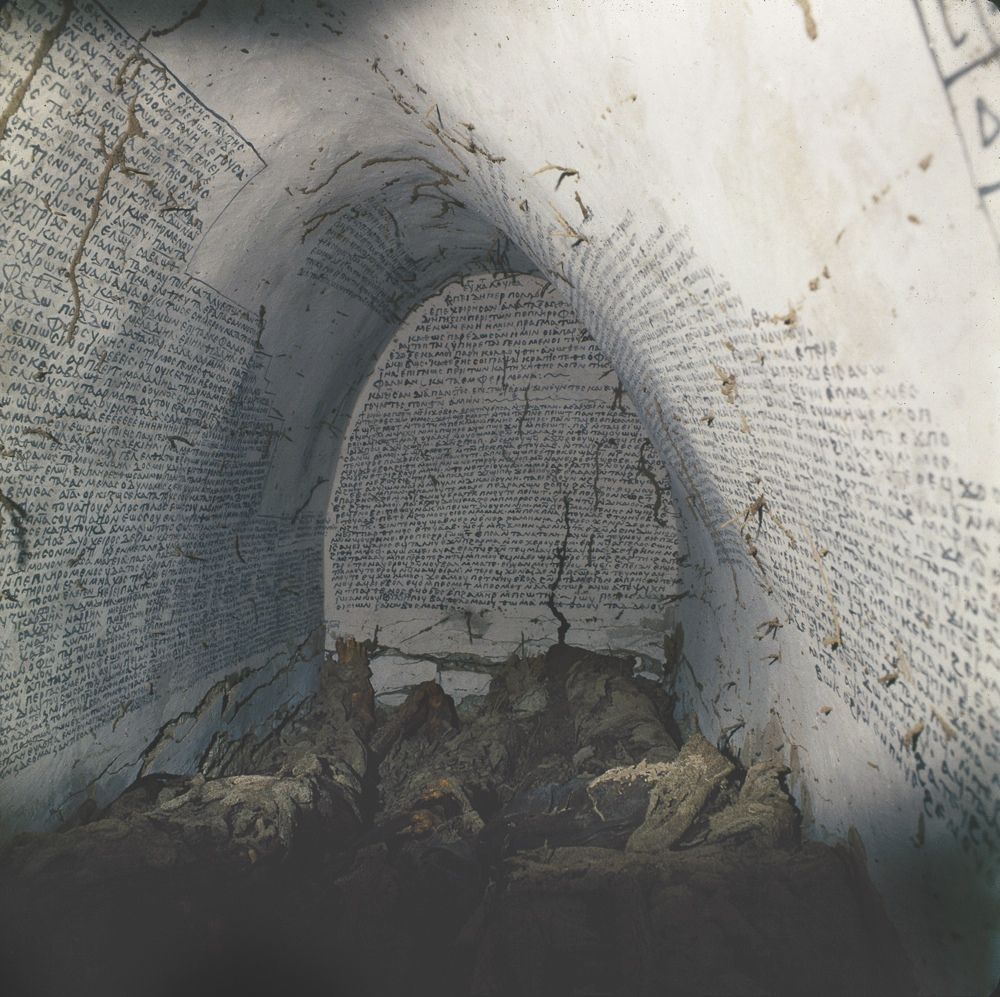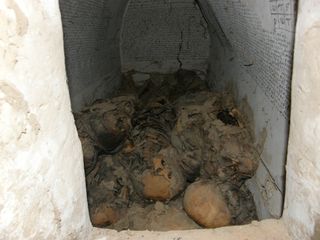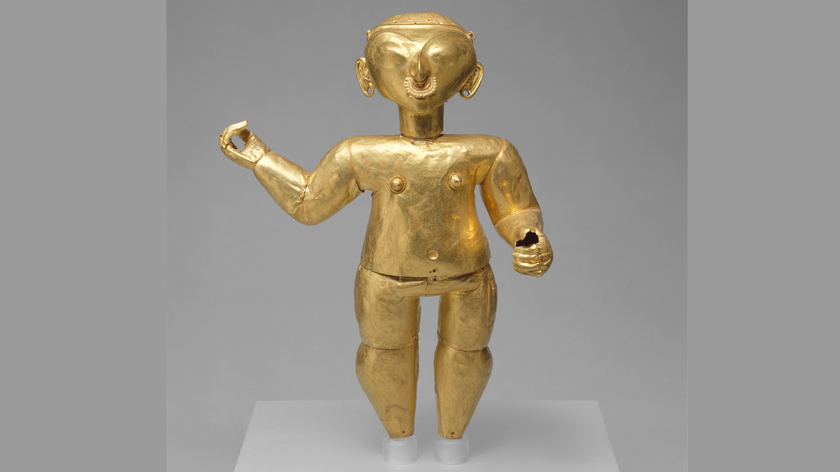Inscriptions Everywhere! Magical Medieval Crypt Holds 7 Male Mummies

A 900-year-old medieval crypt, containing seven naturally mummified bodies and walls covered with inscriptions, has been excavated in a monastery at Old Dongola, the capital of a lost medieval kingdom that flourished in the Nile Valley.
Old Dongola is located in modern-day Sudan, and 900 years ago, it was the capital of Makuria, a Christian kingdom that lived in peace with its Islamic neighbor to the north.
One of the mummies in the crypt (scientists aren't certain which one) is believed to be that of Archbishop Georgios, probably the most powerful religious leader in the kingdom. His epitaph was found nearby and says that he died in A.D. 1113 at the age of 82. [The Science of Death: 10 Tales from the Crypt & Beyond]
Magical inscriptions
The inscriptions on the walls of the crypt, inscribed with black ink on a thin layer of whitewash (paint), were written in Greek and Sahidic Coptic. They include excerpts from the gospels of Luke, John, Mark and Matthew, magical names and signs and a prayer given by the Virgin Mary, at the end of which death appears to her "in the form of a rooster." After Mary dies, according to the text, she ascends to heaven with Jesus.

The inscriptions, written by "Ioannes," who left a signature on three and possibly four of the walls, likely served as protection for the deceased against evil powers, the researchers said.
They were "intended to safeguard not only the tomb, but primarily those who were buried inside of it during the dangerous liminal period between the moment of dying and their appearance before the throne of God," write Adam Łajtar, of the University of Warsaw, and Jacques van der Vliet, of Leiden University, in the most recent edition of the journal Polish Archaeology in the Mediterranean.
Sign up for the Live Science daily newsletter now
Get the world’s most fascinating discoveries delivered straight to your inbox.
The crypt contained the bodies of seven older males, no younger than 40, said anthropologist Robert Mahler, a researcher with the University of Warsaw who examined the remains.
The crypt was likely sealed after the last of the burials took place. "The entrance to the chamber was closed with red bricks bonded in mud mortar," writes Włodzimierz Godlewski, the current director of the Polish Mission to Dongola, in an article in the same journal.
While the mummies' clothing is very poorly preserved, textile specialist Barbara Czaja-Szewczak, with the Wilanów Palace Museum, determined the men were dressed very simply, mainly in linen garments. The garments "consisted of robes characterized by a fairly simple design. Linen predominated," she wrote in an article in the same journal. At least some of the individuals wore crosses somewhere on their body.
The crypt was first found in 1993 by the Polish Mission to Dongola, which at the time was led by director Stefan Jakobielski. However, it wasn't excavated until 2009. During excavations, the bodies were removed and studied, the crypt walls cleaned and its inscriptions recorded and studied in greater detail. Research efforts are ongoing and a complete record of the texts is expected to be detailed in a book in the future.
A lost kingdom
At the time the crypt was created, Makuria was at its height. Its kings, ruling from Old Dongola, controlled territory throughout much of modern-day Sudan and parts of southern Egypt. [See Photos of Sudan's Beautiful Pyramids]
"The period between the late eighth and 12th centuries is claimed to have been the golden age of Makuria," said Artur Obluski, a research associate with the University of Chicago's Oriental Institute and the University of Warsaw's Polish Centre of Mediterranean Archaeology, at a recent lecture at Toronto's Royal Ontario Museum.
Makuria's ability to maintain good relations with its Islamic neighbor to the north, the Fatimid Caliphate, which controlled Egypt, was important to the kingdom's success, said Obluski. The two had an extensive trade relationship, and many people from Makuria served in the Fatimid army.
Arab historians at the time were impressed by the Christian monasteries they saw at Makuria. Though some reports of these monasteries were exaggerated, archaeologists have found some fantastic medieval churches, including recently excavated examples at Banganarti.
Makuria's end came when the Ayyubid dynasty took control of Egypt in A.D. 1171. They launched an invasion of northern Makuria, bringing about a period of decline and eventually the loss of the kingdom's independence.
Follow us @livescience, Facebook & Google+. Original article on LiveScience.

Owen Jarus is a regular contributor to Live Science who writes about archaeology and humans' past. He has also written for The Independent (UK), The Canadian Press (CP) and The Associated Press (AP), among others. Owen has a bachelor of arts degree from the University of Toronto and a journalism degree from Ryerson University.











